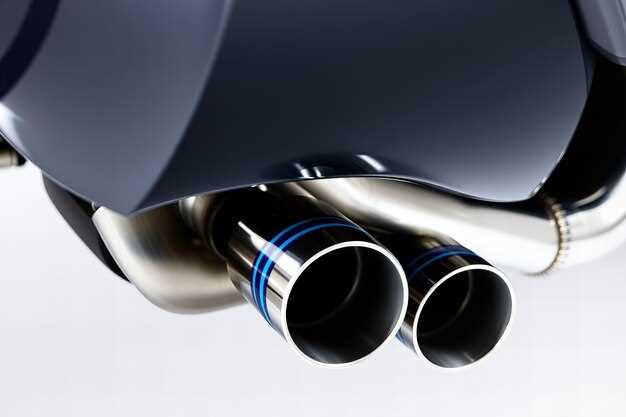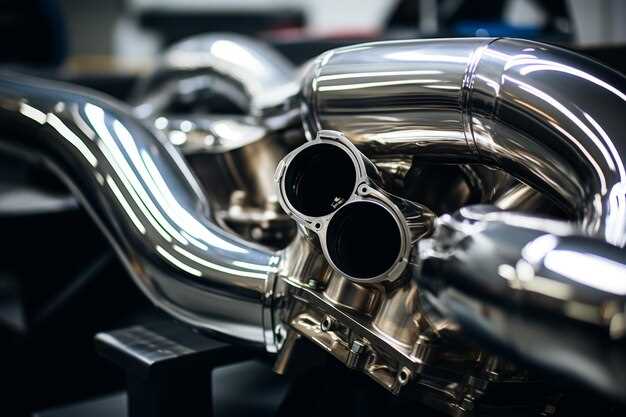
When it comes to enhancing the performance of V8 muscle cars, few modifications can match the impact of a high-quality aftermarket exhaust system. These systems not only improve the vehicle’s power output but also deliver an unmistakable sound that enthusiasts crave. With a myriad of options available on the market, selecting the right exhaust system can be a game-changer, transforming your ride into a true powerhouse.
Aftermarket exhaust systems are designed to optimize airflow, reduce back pressure, and increase engine efficiency. By replacing the factory system, car owners can unlock additional horsepower and torque, resulting in a more exhilarating driving experience. Whether you’re aiming for a mild upgrade or a full-performance overhaul, the right exhaust system can dramatically boost your car’s capabilities.
In this article, we delve into the top aftermarket exhaust systems specifically designed for V8 muscle cars. From renowned brands that prioritize performance to unique features that cater to specific driving styles, we’ll provide insights to help you make an informed decision. Get ready to discover how you can elevate your muscle car’s performance and sound to new heights.
Choosing the Right Material for Your Exhaust System
When it comes to upgrading the exhaust system of your V8 muscle car, selecting the right material is crucial for performance, durability, and sound quality. There are several commonly used materials, each with its own advantages and disadvantages.
Stainless steel is one of the most popular choices due to its high resistance to corrosion and rust. This material is ideal for those who drive in varying weather conditions or live in regions with high humidity. Stainless steel exhaust systems can withstand high temperatures and maintain structural integrity over time, making them a long-lasting investment.
Another option is aluminized steel, which offers a more budget-friendly alternative. While it is lighter and provides good performance, aluminized steel is less resistant to corrosion compared to stainless steel. As a result, it may not be the best choice for those looking for longevity, especially in harsh climates. However, if your muscle car is primarily used in fair weather, this material can be a practical option.
Some high-end exhaust systems are made from titanium, known for its lightweight properties and exceptional strength. Titanium exhaust systems provide a distinctive sound and can significantly reduce the overall weight of the vehicle. Although they come with a higher price tag, their performance benefits and unique aesthetic appeal can justify the investment for dedicated enthusiasts.
Lastly, mild steel is another material used in some aftermarket exhaust systems. While it is less expensive and can offer decent performance, it is more prone to rust and deterioration over time, especially if not properly maintained. Choosing mild steel may be suitable for temporary setups or budget builds, but for long-term use, it’s recommended to consider options like stainless or titanium.
Ultimately, the right material for your exhaust system depends on your specific needs, driving conditions, and budget. Assessing these factors will help you make an informed decision, ensuring you achieve the desired performance and sound for your V8 muscle car.
Performance Gains: What to Expect from Aftermarket Exhausts
Upgrading to an aftermarket exhaust system is one of the most popular modifications for V8 muscle cars, and for good reason. These systems offer significant performance gains that can enhance both the driving experience and overall vehicle efficiency.
When considering an aftermarket exhaust, you can expect the following performance improvements:
- Increased Horsepower: Aftermarket exhaust systems are designed to reduce backpressure, allowing the engine to expel exhaust gases more efficiently. This improved flow can translate to an increase in horsepower, often ranging from 10% to 25%, depending on the specific setup.
- Enhanced Torque: Alongside horsepower, torque figures can see a notable boost. This is especially beneficial for acceleration and low-end power, making your muscle car feel more responsive during everyday driving and when pushing the limits on the track.
- Improved Exhaust Flow: Most factory exhaust systems are designed with sound compliance and cost in mind, resulting in limitations on airflow. Aftermarket options generally feature larger diameter piping and improved muffler designs that facilitate smoother exhaust flow.
- Weight Reduction: Aftermarket exhaust systems are often lighter than stock components. Using materials like stainless steel or titanium not only enhances durability but also contributes to overall weight savings, which can positively affect performance and handling.
- Better Throttle Response: A less restrictive exhaust system enhances engine breathing, resulting in a more immediate throttle response. This improvement can make the driving experience more exhilarating and engaging.
While performance gains are enticing, it’s essential to consider the following factors when selecting an aftermarket exhaust:
- Type of Exhaust System: Consider whether you want a cat-back, axle-back, or header-back exhaust system, as each option offers different performance benefits.
- Muffler Design: Different muffler designs can produce various sound profiles. Flow-through designs typically offer better performance but may generate louder exhaust notes.
- Material Choices: While stainless steel offers durability and resistance to rust, lighter materials may enhance performance further. Weigh the benefits of both options.
- Compatibility with Other Modifications: Ensure that the aftermarket exhaust system you choose complements other performance modifications, like cold air intakes or tuning, for optimal gains.
In summary, aftermarket exhaust systems can yield substantial performance gains for V8 muscle cars, improving horsepower, torque, and throttle response while offering a more aggressive sound. Choosing the right system tailored to your driving style and vehicle needs will unlock the true potential of your muscle car.
Sound Comparison: Different Styles and Configurations

When selecting an aftermarket exhaust system for V8 muscle cars, understanding the sound produced by different styles and configurations is crucial for achieving the desired performance and aesthetic appeal. The exhaust note plays a significant role in the overall driving experience, and various setups can yield distinctly different sounds.
- Cat-Back Exhaust Systems
- Generally, these systems replace the exhaust components from the catalytic converter to the rear of the vehicle.
- They often provide a deep, aggressive tone that enhances the natural growl of V8 engines.
- Performance improvements can include increased horsepower and improved throttle response due to reduced backpressure.
- Axle-Back Exhaust Systems
- These systems focus on the components located behind the rear axle.
- They tend to produce a more subtle sound, preserving some of the factory tones while adding warmth and depth.
- Ideal for those seeking a performance boost without major changes to the overall sound profile.
- Header-Back Exhaust Systems
- This comprehensive approach replaces the entire system from the headers back, maximizing performance and sound.
- Typically results in a loud, powerful exhaust note that commands attention.
- Best suited for track or performance-focused builds, where sound intensity is as vital as performance gains.
- Chambered Mufflers
- These features internal chambers that create a unique sound profile, often with a rumbling quality.
- They are popular among muscle car enthusiasts aiming for a classic American V8 sound.
- Performance-wise, chambered mufflers can improve exhaust flow while providing a distinctive audio character.
- Straight-Through Mufflers
- Designed to allow exhaust gases to flow freely, resulting in minimal restriction and a loud, aggressive tone.
- These are favored by many in the racing community for their capability to maximize horsepower.
- However, the sound can be quite loud, which may not appeal to all drivers.
Ultimately, the choice of exhaust system and configuration greatly impacts both sound and performance. Enthusiasts should consider their personal sound preferences, driving conditions, and overall goals when selecting the ideal setup for their V8 muscle cars.
Installation Tips for Optimal Performance
When installing an aftermarket exhaust system for your V8 muscle car, careful attention to detail can significantly enhance performance. Start by ensuring that you have all the necessary tools and components before beginning the installation. Quality tools facilitate a smoother process and help prevent damage to parts.
Next, consider the use of high-temperature gaskets and clamps, which provide better sealing and durability under high-performance conditions. Regular clamps may fail under increased heat and pressure, leading to exhaust leaks that can harm overall performance.
Proper alignment of the exhaust system is crucial. Misalignment can result in unwanted stress on pipes and flanges, potentially leading to cracks and leaks. It’s essential to hang the system loosely during installation and make adjustments as needed before tightening everything down.
Piping diameter can significantly influence exhaust flow. Ensure that the diameter of the new system matches or is optimized for your specific engine setup. Wider pipes can improve flow but may affect low-end torque, so balance is key for optimal performance across the power band.
Don’t forget to pay attention to the placement of oxygen sensors. If your system includes an option for high-performance catalytic converters, ensure sensors are positioned correctly to maintain precise fuel management, maximizing efficiency and performance.
Finally, after installation, conduct a thorough check for leaks and secure all fittings and hangers. A leak-free system ensures that exhaust gases flow efficiently, contributing to peak performance and enhancing the overall driving experience of your muscle car.
Maintaining Your Aftermarket Exhaust System

Proper maintenance of your aftermarket exhaust system is crucial for preserving its performance and longevity. Regular inspections and care can prevent costly repairs and ensure your muscle car runs optimally. Here are essential maintenance tips to keep your exhaust system in top shape.
| Maintenance Task | Frequency | Description |
|---|---|---|
| Visual Inspection | Monthly | Check for visible signs of damage, rust, or loose connections. |
| Check Seals and Joints | Every 3 Months | Inspect gaskets and clamps to ensure there are no leaks affecting performance. |
| Clean the Exhaust Tips | Every 6 Months | Remove carbon build-up for improved aesthetics and exhaust flow. |
| Inspect Hangars | Annually | Ensure exhaust hangers are secure and replace any that are worn or damaged. |
| Professional Inspection | Every 2 Years | Schedule a comprehensive check-up by a technician to assess overall health. |
Taking these steps can help you maximize the performance of your aftermarket exhaust system while minimizing the risk of premature failure. A well-maintained exhaust system not only enhances your vehicle’s sound but also contributes to its overall efficiency.
Cost vs. Performance: Finding the Best Value Exhausts
When selecting an aftermarket exhaust system for V8 muscle cars, striking the right balance between cost and performance is crucial. Numerous options are available, each promising improvements in power, sound, and efficiency, but not all deliver on performance for the price paid.
Performance gains can be attributed to several factors, including pipe diameter, material composition, and design. Systems made from high-grade stainless steel or aluminized steel often provide better longevity and corrosion resistance, resulting in sustained performance over time. However, the initial investment can vary significantly. It’s essential to weigh the financial outlay against the expected performance enhancements.
Budget-friendly exhausts might enhance the sound and provide modest performance improvements, making them attractive to entry-level enthusiasts. Yet, serious performance seekers may find that these systems often fall short in terms of power output and efficiency gains compared to their pricier counterparts. Investing in higher-end exhaust systems typically yields superior flow characteristics, optimizing engine performance without excessive back pressure.
Another consideration is the compatibility of the exhaust system with other modifications. If a vehicle is already equipped with a high-performance engine or intake system, opting for a quality exhaust is vital to maximize the overall performance package. In such cases, a slightly higher cost can result in significant performance benefits, justifying the investment.
Ultimately, finding the best value exhaust requires careful analysis of performance metrics relative to cost. Dedicating time to research, reading user reviews, and consulting with experts can help identify systems that offer the best combination of affordability and performance. A well-chosen exhaust system will not only enhance the driving experience but also serve as a valuable component of a muscle car’s overall performance strategy.




